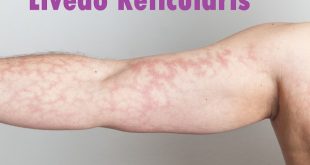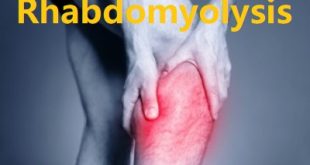Definition
Raynaud’s phenomenon (RP) is a disorder resulting in vasospasm, a particular series of discolorations of the fingers and/or the toes after exposure to changes in temperature (cold or hot) or emotional events. Most people with RP have sensitivity to cold. Skin discoloration occurs because an abnormal spasm of the blood vessels causes diminished blood flow to the local tissues. Initially, the digit(s) involved turning white because of the diminished blood flow. The digit(s) then turn blue (cyanosis) because of a prolonged lack of oxygen. Finally, the blood vessels reopen, causing a local “flushing” phenomenon, which turns the digit(s) red. This three-phase color sequence (white to blue to red), most often upon exposure to cold temperature, is characteristic of RP.
Raynaud’s phenomenon most frequently affects women, especially in the second, third, or fourth decades of life. People can have Raynaud’s phenomenon alone or as a part of other rheumatic diseases. Raynaud’s phenomenon in children is essentially identical to Raynaud’s phenomenon in adults. When it occurs alone, it is referred to as “Raynaud’s disease” or primary Raynaud’s phenomenon. When it accompanies other diseases, it is called secondary Raynaud’s phenomenon.
Types of Raynaud’s Phenomenon
Primary Raynaud’s
This is often a mild condition and there are ways to help manage the symptoms. People with primary Raynaud’s usually have no other related complications, and will rarely go on to develop an additional problem. If you have primary Raynaud’s, it is important to see your GP if you are worried about the symptoms or any other health issues.
Secondary Raynaud’s
This means that Raynaud’s is caused by another condition, usually an autoimmune disease like scleroderma or lupus. Secondary Raynaud’s needs more investigation and more careful monitoring for complications like ulceration or sores.
Risk factors of Raynaud’s Phenomenon
As many as one in 10 people may have some form of Raynaud’s, with most of those having the primary form. About one person in 100, or fewer, will have secondary Raynaud’s.
- Women are up to nine times more likely to get it than men are.
- All ages people can get Raynaud’s, but it usually starts showing up between ages 15 and 25.
- People with secondary Raynaud’s tend to get it after 35.
- Illnesses like rheumatoid arthritis, scleroderma, and lupus are more likely to get secondary Reynaud’s.
- People who use some medicines to treat cancer, migraines, or high blood pressure may be more likely to get Raynaud’s.
- Also, people who have carpal tunnel syndrome or use vibrating tools like jackhammers may be more likely to get Raynaud’s.
Raynaud’s Phenomenon Causes
For children with primary Raynaud’s, we don’t yet know what causes their blood vessels to react in such a vigorous way to cold and emotional stress.
However, there are concrete causes for secondary Raynaud’s, and in children it’s most often an underlying autoimmune disease. Here at Children’s Hospital Boston, the illnesses we tend to see with secondary Raynaud’s are:
- Scleroderma, which leads to the hardening and scarring of the skin and other body tissues (about 90 percent of those with scleroderma also have Raynaud’s)
- Systemic lupus erythematosus (SLE, or simply lupus), which can cause inflammation and damage in many parts of the body, especially the heart, lungs, kidneys and brain (about a third of those with lupus also have Raynaud’s)
- Mixed connective tissue disease, an “overlap” disease that has features of scleroderma, lupus, polymyositis and sometimes rheumatoid arthritis
- Vasculitis, which causes inflammation of the blood vessels
Diseases like arteriosclerosis and hypertension can also damage the blood vessels and cause secondary Raynaud’s, though almost always in adults. Other potential causes of secondary Raynaud’s include:
- Medications: Certain kinds of drugs have been linked to Raynaud’s, such as beta blockers (used to treat high blood pressure), migraine prescriptions with ergotamine, medications with estrogen, drugs containing caffeine (such as Excedrin), medications used for ADHD (like Ritalin) and some over-the-counter decongestants.
- Injury to the hands and feet: Frostbite is a notable culprit in this category, but things like repetitive trauma seen mainly in adults who work with vibrating tools, like drills can also trigger Raynaud’s.
Symptoms of Raynaud’s Phenomenon
The symptoms of Raynaud’s disease can include:
Extreme sensitivity to cold: Your body also may react to emotional stress as if it were reacting to cold.
Skin colour changes: Fingers, toes, and sometimes the ears, lips and nose turn white due to lack of blood flow. The blood that’s left in the tissues loses its oxygen and the affected area turns blue. As fresh oxygen-rich blood returns to the area, it often turns bright red.
Coldness, pain and numbness: These are triggered by a lack of oxygenated blood in the fingers. The numbness is the same as when your hand or fingers have “fallen asleep”.
Warmth, tingling and throbbing: The quick return of blood to the fingers triggers these feelings.
Skin ulcers and gangrene: For people with severe undiagnosed Raynaud’s and attacks that last a long time, painful, slow-healing sores may occur in the finger tips. In rare cases, a long-term lack of oxygen to the tissues can result in gangrene (when a body part loses its blood supply).
Raynaud’s Phenomenon complications
In most cases, Raynaud’s phenomenon is harmless and has no lasting effects. However, in severe cases loss of blood flow can permanently damage the tissue.
Complications of severe Raynaud’s phenomenon include:
- Impaired healing of cuts and abrasions
- Increased susceptibility to infection
- Ulceration
- Tissue loss
- Scarring
- Gangrene
Talk with your doctor if you notice any of these problems or if you notice other changes to your symptoms.
Diagnosis and test
There are various tests your doctor can carry out if they suspect you have Raynaud’s phenomenon.
- Blood tests can show how many white and red blood cells you have, as well as other information that will help a doctor decide if you have Raynaud’s. Blood tests can also help to show if you have primary or secondary Raynaud’s.
- An x-ray can look for an extra rib at the base of the neck, called a cervical rib. This can cause Raynaud’s phenomenon by putting pressure on the blood vessels that supply blood to your arms.
- Nailfold microscopy or Capillaroscopy: This test that involves looking at the tissue from a fingernail under a microscope. It will help doctors look closely at the small blood vessels in your fingers..
- A cold stress test, or thermography, is used in some hospitals to find out how you react to cold. It involves using cold water and recording how long it takes for part of the feet or hands to return to their normal temperature.
If you have scleroderma, it’s likely that you’ll get Raynaud’s symptoms at some stage. However, having Raynaud’s doesn’t mean that you’ll go on to develop scleroderma or another connective tissue disease.
Treatment and medications
Dressing for the cold in layers and wearing gloves or heavy socks usually are effective in dealing with mild symptoms of Raynaud’s. Medications are available to treat more-severe forms of the condition. The goals of treatment are to:
- Reduce the number and severity of attacks
- Prevent tissue damage
- Treat the underlying disease or condition
Medications
Depending on the cause of your symptoms, medications might help. To widen (dilate) blood vessels and promote circulation, your doctor might prescribe:
Calcium channel blockers: These drugs relax and open small blood vessels in your hands and feet, decreasing the frequency and severity of attacks in most people with Raynaud’s. These drugs can also help heal skin ulcers on your fingers or toes. Examples include nifedipine (Afeditab CR, Procardia, others), amlodipine (Norvasc), felodipine and isradipine.
Vasodilators: These drugs, which relax blood vessels, include nitroglycerin cream applied to the base of your fingers to help heal skin ulcers. Other vasodilators include the high blood pressure drug losartan (Cozaar), the erectile dysfunction medication sildenafil (Viagra, Revatio), the antidepressant fluoxetine (Prozac, Sarafem, others) and a class of medications called prostaglandins.
Surgeries and medical procedures
For some cases of severe Raynaud’s, procedures that might be treatment options include:
Nerve surgery: Sympathetic nerves in your hands and feet control the opening and narrowing of blood vessels in your skin. Cutting these nerves interrupts their exaggerated responses. Through small incisions in the affected hands or feet, a doctor strips these tiny nerves around the blood vessels. This surgery (sympathectomy), if successful, might reduce the frequency and duration of attacks.
Chemical injection: Doctors can inject chemicals such as local anesthetics or onabotulinumtoxin type A (Botox) to block sympathetic nerves in affected hands or feet. You might need to have the procedure repeated if symptoms return or persist.
Prevention of Raynaud’s Phenomenon
Be aware of workplace hazards that cause Raynaud’s phenomenon, and take the precautions needed to prevent vibration and cold exposure.
General Precautions
- Protect the hands from damage and extreme temperatures.
- Keep warm at work – wear gloves and warm clothing when working in the cold.
- Massage and exercise your fingers during your breaks.
- If tingling, numbness or signs of white finger develop, promptly consult a physician.
Precautions with Vibrating Tools
Anti-vibration tools, anti-vibration gloves, and anti-vibration shields may help reduce exposure to vibration.
In general, grinding, machining, and vibrating processes should be as fully automated as possible. Workers should use vibrating tools only when necessary.
There are several ways to reduce the amount of vibration that passes from the tool to the hands.
- Use only well-maintained and properly operating tools.
- Hold vibrating tools as lightly as possible, consistent with safe work practices. Let the tool do the work.
- Rest vibrating tools on a support or work piece as much as possible.
- Store tools so that they do not have cold handles when next used.
- Use proper job design with scheduled breaks to reduce exposure to vibration.
It is important for workers to recognize if early symptoms of Raynaud’s phenomenon have occurred, and then get appropriate advice to reduce further exposure to vibration.
 Diseases Treatments Dictionary This is complete solution to read all diseases treatments Which covers Prevention, Causes, Symptoms, Medical Terms, Drugs, Prescription, Natural Remedies with cures and Treatments. Most of the common diseases were listed in names, split with categories.
Diseases Treatments Dictionary This is complete solution to read all diseases treatments Which covers Prevention, Causes, Symptoms, Medical Terms, Drugs, Prescription, Natural Remedies with cures and Treatments. Most of the common diseases were listed in names, split with categories.







